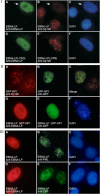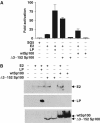Mediation of Epstein-Barr virus EBNA-LP transcriptional coactivation by Sp100
- PMID: 16177824
- PMCID: PMC1276704
- DOI: 10.1038/sj.emboj.7600820
Mediation of Epstein-Barr virus EBNA-LP transcriptional coactivation by Sp100
Abstract
The Epstein-Barr virus (EBV) EBNA-LP protein is important for EBV-mediated B-cell immortalization and is a potent gene-specific coactivator of the viral transcriptional activator, EBNA2. The mechanism(s) by which EBNA-LP functions as a coactivator remains an important question in the biology of EBV-induced B-cell immortalization. In this study, we found that EBNA-LP interacts with the promyelocytic leukemia nuclear body (PML NB)-associated protein Sp100 and displaces Sp100 and heterochromatin protein 1alpha (HP1alpha) from PML NBs. Interaction between EBNA-LP and Sp100 was mediated through conserved region 3 in EBNA-LP and the PML NB targeting domain in Sp100. Overexpression of Sp100 lacking the N-terminal PML NB targeting domain, but not a mutant form of Sp100 lacking the HP1alpha interaction domain, was sufficient to coactivate EBNA2 in a gene-specific manner independent of EBNA-LP. These findings suggest that Sp100 is a major mediator of EBNA-LP coactivation. These studies indicate that modulation of PML NB-associated proteins may be important for establishment of latent viral infections, and also identify a convenient model system to investigate the functions of Sp100.
Figures






References
-
- Allan GJ, Inman GJ, Parker BD, Rowe DT, Farrell PJ (1992) Cell growth effects of Epstein–Barr virus leader protein. J Gen Virol 73: 1547–1551 - PubMed
Publication types
MeSH terms
Substances
Grants and funding
LinkOut - more resources
Full Text Sources
Molecular Biology Databases
Research Materials
Miscellaneous

